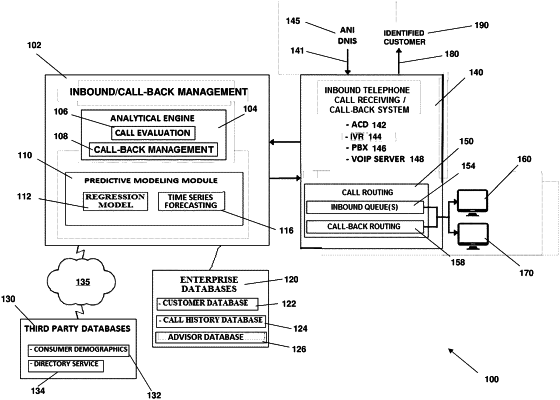| CPC G06Q 30/016 (2013.01) [G06N 20/00 (2019.01)] | 13 Claims |

|
1. A processor-based method, comprising:
training, by a processor, a logistic regression model using a dataset having a plurality of features corresponding to historical calls, the logistic regression model trained by applying regularization to feature selection in repeated iterations;
upon receiving a customer call at a call center of an enterprise from an inbound caller, opening, by the processor, an inbound call record for an identified customer including any automatic number identifier information delivered with the customer call;
monitoring, by the processor, the customer call of the inbound caller to retrieve one or more of interactive voice response (IVR) data received from the inbound caller via interaction with an interactive voice response unit and inbound queue data retrieved by monitoring an inbound call queue including the inbound caller, and updating the inbound call record for the inbound caller with the one or more of the IVR data and the inbound queue data retrieved;
analyzing, by the processor, the one or more of the IVR data and the inbound queue data to detect any termination of the inbound call by exercising a call-back option via the interactive voice response unit or by abandoning the customer call, and in the event of detecting the termination of the customer call:
opening, by the processor, a call-back record for the identified customer including call-back data comprising any automatic number identifier information delivered, and the one or more of the IVR data and the inbound queue data in the inbound call record;
retrieving, by the processor, from a customer relationship management database of the enterprise any call associated information for any previous call interaction of the identified customer with one or more of a plurality of advisors of the enterprise, and adding any call associated information retrieved to the call-back data in the call-back record for the identified customer;
executing, by the processor, the logistic regression model to generate output data comprising (i) a call-back signal representative of a likelihood of repeated call-backs by the identified customer and (ii) an interaction signal representative of a likelihood that the identified customer will perform a predetermined interaction during a future call-back, by applying to the call-back data in the call-back record for the identified customer in the logistic regression model utilizing time series forecasting to generate a plurality of call-back metrics representative of likelihood of call-backs, wherein the logistic regression model applies regularization to feature selection in repeated iterations of model training, the logistic regression model trained to generate the call-back signal and the interaction signal as output;
classifying, by the logistic regression model executing on the processor, based on the call-back signal and the interaction signal determined by the logistic regression model, the identified customer into one of a first call-back group and a second call-back group;
in the event the identified customer is classified into the first call-back group, initiating a call back between the identified customer and a preferred agent of the call center; and
in the event the identified customer is classified into the second call-back group, directing an automatic calling device in communication with the processor to automatically execute a subordinate call-back procedure.
|